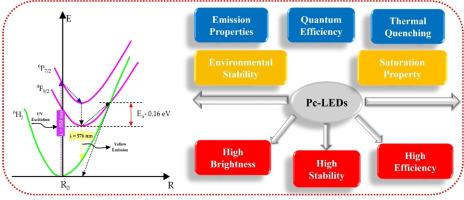Novel dysprosium-doped phosphate phosphor comprising alkali and alkaline earth metals as a versatile thermally stable luminescent material
IF 4.7
2区 化学
Q2 CHEMISTRY, PHYSICAL
引用次数: 0
Abstract
In this work, a series of KNa1-xDyx Ba2(PO4)2 (where x = 1.5–3.5 mol%, in steps of 0.5 mol%) phosphors were successfully prepared using a conventional high-temperature solid-state synthesis approach. The phase purity of the synthesized material was identified via powder XRD and subsequently verified by Rietveld refinement, which revealed a single-phase trigonal crystal structure with space group Pm1 (No. 164). Surface morphology was analysed by SEM, which showed that the samples consist of multiple block-like structures formed by loosely arranged aggregated particles, with an average particle size of 0.59633 ± 0.02981 µm. The FTIR spectra exhibited strong, distinct vibrational bands corresponding to phosphate (PO₄³⁻) groups, indicating the successful incorporation of Dy³⁺ ions without any disruption to the host matrix. Photoluminescence emission spectra recorded under 350 nm excitation show blue and yellow emission bands attributed to ⁴F9/2 ⁶H15/2 (481 nm & 485 nm) and ⁴F9/2 ⁶H13/2 (576 nm) transitions of Dy³⁺, respectively. According to Dexter's theory, concentration quenching was observed at 2.5 mol% of Dy³⁺, primarily due to dipole-dipole interactions. The DRS approach was employed to calculate the optical band gap, yielding values of 6.11 eV (for undoped sample) and 6.21 eV (for the optimised sample). Additionally, analysis of the nephelauxetic effect indicated that Dy3+ ions form covalent bonds with surrounding ligands in the host structure. The optical characteristics, based on CIE 1931 analysis, show that the impurity-optimized sample exhibits CIE chromaticity coordinates of (0.413060, 0.444039), a dominant emission wavelength (λd) of 574.1 nm (yellow colour), colour purity of 57.3 %, and a correlated colour temperature (CCT) of around 3721 K, supporting its suitability for warm-white LED applications. Temperature-dependent CIE results indicate that even at elevated temperatures, the emission wavelength remains stable, with the phosphor retaining 83 % of its initial emission intensity at 423 K. Furthermore, fluorescence intensity ratio (FIR)-based thermal sensing revealed a maximum relative sensitivity (SR) of 0.96 % K⁻¹ observed at 298 K estimated over the 298–500 K range, demonstrating the material potential for optical thermometry applications.

由碱金属和碱土金属组成的新型掺镝磷光体是一种多用途的热稳定发光材料
本文采用传统的高温固态合成方法成功制备了一系列KNa1-xDyx Ba2(PO4)2(其中x = 1.5-3.5 mol%,步骤为0.5 mol%)荧光粉。通过粉末XRD对合成材料的相纯度进行了鉴定,随后通过Rietveld细化进行了验证,发现合成材料为空间群为P3¯m1 (No. 164)的单相三角晶体结构。通过SEM对样品表面形貌进行分析,发现样品由松散排列的颗粒聚集形成多个块状结构,平均粒径为0.59633±0.02981µm。FTIR光谱显示出与磷酸(PO₄³⁻)基团对应的强而明显的振动带,表明Dy³⁺的离子成功结合,而没有破坏宿主基质。在350 nm激发下记录的光致发光发射光谱显示,Dy³⁺的蓝色和黄色发射带分别属于⁴F9/2→⁶H15/2 (481 nm & 485 nm)和⁴F9/2→⁶H13/2 (576nm)跃迁。根据Dexter的理论,在2.5 mol%的Dy³+中观察到浓度猝灭,主要是由于偶极子-偶极子相互作用。采用DRS方法计算光学带隙,产生值为6.11 eV(未掺杂样品)和6.21 eV(优化样品)。此外,对散射效应的分析表明,在宿主结构中,Dy3+离子与周围的配体形成共价键。基于CIE 1931分析的光学特性表明,杂质优化样品的CIE色度坐标为(0.413060,0.444039),主发射波长(λd)为574.1 nm(黄色),色纯度为57.3%,相关色温(CCT)约为3721 K,支持其适合暖白光LED应用。温度相关的CIE结果表明,即使在高温下,发射波长仍然保持稳定,荧光粉在423 K时保持其初始发射强度的83%。此外,基于荧光强度比(FIR)的热传感显示,在298 - 500 K范围内观察到的最大相对灵敏度(SR)为0.96% K - 1,证明了光学测温应用的材料潜力。
本文章由计算机程序翻译,如有差异,请以英文原文为准。
求助全文
约1分钟内获得全文
求助全文
来源期刊

Journal of Molecular Structure
化学-物理化学
CiteScore
7.10
自引率
15.80%
发文量
2384
审稿时长
45 days
期刊介绍:
The Journal of Molecular Structure is dedicated to the publication of full-length articles and review papers, providing important new structural information on all types of chemical species including:
• Stable and unstable molecules in all types of environments (vapour, molecular beam, liquid, solution, liquid crystal, solid state, matrix-isolated, surface-absorbed etc.)
• Chemical intermediates
• Molecules in excited states
• Biological molecules
• Polymers.
The methods used may include any combination of spectroscopic and non-spectroscopic techniques, for example:
• Infrared spectroscopy (mid, far, near)
• Raman spectroscopy and non-linear Raman methods (CARS, etc.)
• Electronic absorption spectroscopy
• Optical rotatory dispersion and circular dichroism
• Fluorescence and phosphorescence techniques
• Electron spectroscopies (PES, XPS), EXAFS, etc.
• Microwave spectroscopy
• Electron diffraction
• NMR and ESR spectroscopies
• Mössbauer spectroscopy
• X-ray crystallography
• Charge Density Analyses
• Computational Studies (supplementing experimental methods)
We encourage publications combining theoretical and experimental approaches. The structural insights gained by the studies should be correlated with the properties, activity and/ or reactivity of the molecule under investigation and the relevance of this molecule and its implications should be discussed.
 求助内容:
求助内容: 应助结果提醒方式:
应助结果提醒方式:


